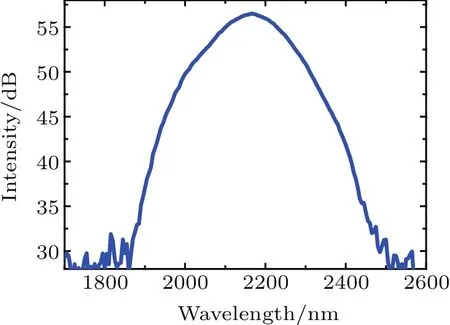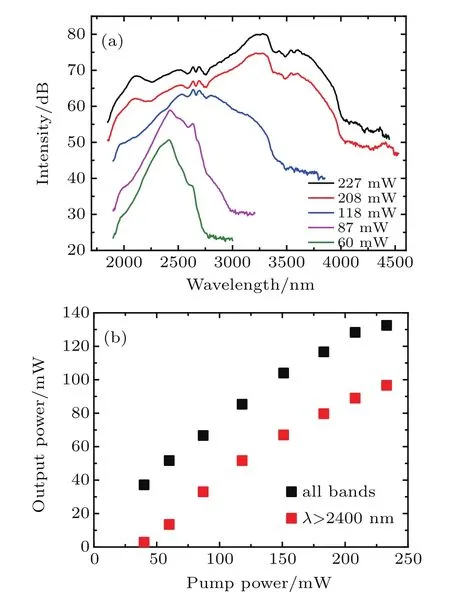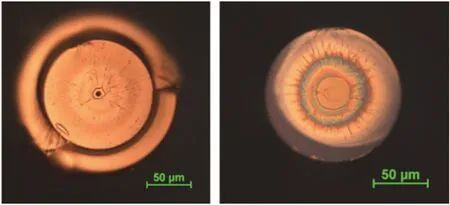Monolithic all- fiber mid-infrared supercontinuum source based on a step-index two-mode As2S3 fiber∗
2019-06-18JinmeiYao姚金妹BinZhang张斌andJingHou侯静
Jinmei Yao(姚金妹),Bin Zhang(张斌),2,3,†,and Jing Hou(侯静),2,3
1College of Advanced Interdisciplinary Studies,National University of Defense Technology,Changsha 410073,China
2State Key Laboratory of Pulsed Power Laser Technology,Changsha 410073,China
3Hunan Provincial Key Laboratory of High Energy Laser Technology,Changsha 410073,China
Keywords:supercontinuum generation,infrared lasers, fiber lasers,nonlinear.
1.Introduction
Mid-infrared(MIR)supercontinuum(SC)sources have attracted a signi ficant scientific interest in the past decade due to their wide range of potential applications in fields such as optical coherence tomography,[1]chemical sensing,[2]biomedical imaging and early cancer diagnostics.[3-5]Generally,the SC spectra generated in silica fibers struggle to exceed 2.4µm due to the limited optical transparency of silica glass.To create SC generation tailing to a longer wavelength region,GeO2-doped fibers with extended transmission window up to∼3.6µm are used.[6]To further extend the spectra of SC laser sources beyond 4µm,soft-glass fibers,such as fluoride fibers,[7,8]tellurite fibers,[9]and chalcogenide fibers,are much more suitable.Speci fically,chalcogenide glass fibers facilitating broadband transmittance window and high nonlinear refractive index n2in the infrared region,[10,11]become the most promising medium for MIR SC generation towards far-infrared spectral range.However,typical chalcogenide fibers have large material zero dispersion wavelengths(ZDWs).The material ZDWs of As2S3glass and As2Se3glass are located at∼4.8µm and 8µm,[10]respectively.These ZDWs are far away from the commercial laser sources.Therefore,in order to obtain MIR SC laser sources effectively,chalcogenide fibers with high numerical apertures(NAs)are needed to lower the ZDWs meanwhile con fine MIR light in the core of fibers.[12]But the risk is that higher-order modes(HOMs)tend to be excited in the near-infrared and shortwave-infrared spectral range.Such excitation of HOM is often neglected in previous chalcogenide fiber-based SC studies.Compared with the fundamental mode,HOMs exhibit different dispersion curves and nonlinear indices,which are the most important factors for SC generation.In addition,intermodal nonlinear effects taken place through cross-phase modulation,[13]four-wave mixing[14,15]and stimulated Raman scattering,[16]offeranadditionalpossibilityforspectralbroadening through new degrees of freedom.Hence,it is necessary to investigate HOM SC generation in few-mode chalcogenide fibers.Visible and near-infrared SC generation have been carried out in micro-structured multimode silica fibers[17-19]and graded-index multimode silica fibers,[20-22]while an MIR SC demonstration has been reported in a ZBLAN fiber with anomalous dispersion.[23]Numerical simulations related to multimode SC generation in chalcogenide fibers have been demonstrated,[12,24]yet there are still no explicit experimental validations.
Fiber-based SC laser sources bene fit from their compact con figuration that are needed for robust commercial applications.Compared with lens coupling and butt-coupling,fusion splicing with permanent and robust connection is the best coupling method for fiber-based SC laser.However,it is dif ficult to achieve a real-all- fiber structured MIR SC laser source based on chalcogenide glass fibers.The glass transition temperature is 1215°C for silica glass,while it is 130°C∼300°C for chalcogenide glasses.[5]The signi ficant difference in the two fibers’glass transition temperatures brings a great challenge for fusion splicing them together.The asymmetric heating con figuration has been proved as an ef ficient method for splicing fibers with discrepant transition temperatures.[25-27]In this method,the silica fiber is fusion spliced to the chalcogenide fiber with 0.5 dB of splice loss.[26]
In this paper,we demonstrate MIR SC sources spanning from 1.8µm to 4.2µm using a step-index two-mode As2S3fiber.The asymmetric heating method is used for fusion splicing between the As2S3fiber and the pigtail of nearinfrared SC pump source with an ultra-low insertion loss of 0.125 dB,which enables a monolithic all- fiber structured SC laser.The measured beam pro file reveals that LP11mode is excited within a wide spectral range of 1.8µm-3.5µm.The mixed-mode cascaded stimulated Raman scattering with respect to the fundamental mode and the off-center-alignmentinduced LP11mode,mainly contribute to the spectral broadening.
2.Experimental setup
The experimental setup of the pump source is similar to the structure described in Ref.[25].The pump source is a nanosecond shortwave-infrared SC laser with a repetition rate of 100 kHz and a spectral range of 1.9µm-2.5µm(see Fig.1). Note that the majority power of the pump light is located within the spectral range of 2.1µm-2.2µm.The pigtail fiber of the pump source is an ultra-high numerical aperture(UHNA) fiber with a core/cladding diameter of 2.2µm/125µm and an NA of 0.35.The V-number of UHNA fiber is 1.1 at around 2.19µm,which ensures that the shortwave infrared region holds the single-mode property.A 3-m-long sul fide-based chalcogenide fiber is chosen as the nonlinear fiber due to its lower ZDW than that of selenide-based chalcogenide fibers.The core/cladding diameter of the stepindex As2S3fiber is 9µm/170µm with an NA of 0.3.Since the V-number of the As2S3fiber is 3.87 at around 2.19µm,the SC generation behaves at few-mode scheme,where LP11mode with cut-off wavelength of 3.5µm is the dominant HOM in MIR spectral range.The group-velocity dispersion of the fundamental mode and the LP11mode can be found in Ref.[28].The estimated ZDW for the fundamental mode reaches 6.7µm,while the LP11mode facilitates normal dispersion over the whole MIR spectral range.By using the commercial software(COMSOL Multiphysics),the mode field diameters of the UHNA fiber and the As2S3fiber,corresponding to the fundamental mode at 2.19µm,are estimated to be 7.77µm and 7.99µm,respectively.The mode pro file mismatch between the two fibers is less than 0.01%,indicating a great potential of low-loss fusion splicing of UHNA fiber to the As2S3fiber for integrated MIR SC laser source.
During the fusion splicing,an electrode-based fiber fusion splicer is used to achieve the accurate control of the temperature field,while a continuous-wave fiber laser operating at 1960 nm is adopted to monitor the coupling efficiency.The end facet of the As2S3fiber is angle-cleaved to suppress the unwanted optical feedback from the Fresnel re flection.Figure 2(a)shows the transmission of the splicing point under 1960-nm continuous-wave laser,in which the inset shows the optical microscope image of the fusion splicing joint between the UHNA fiber and the As2S3fiber.Figure 2(a)shows that the coupling efficiency is enhanced along with the increase of continuous-wave power due to the thermal expansion of the core of As2S3fiber.An approximate transmission of 63%is measured at the end of the As2S3fiber.Since the Fresnel refl ection loss between UHNA fiber(n0=1.438 at 2µm)and As2S3fiber(n0=2.426 at 2µm)is about 0.3 dB.The Fresnel re flection loss on the output end facet of As2S3fiber is about 0.825 dB.Thus,the fusion splicing loss is estimated to be∼0.125 dB,by taking the linear propagation loss at 2µm(0.25 dB/m)into account.Figures 2(b)and 2(c)show the end facet of As2S3fiber and UHNA fiber after pulling the joint apart,of which both end facets are well preserved during asymmetric heating and pushing processing.

Fig.1.Shortwave-infrared SC pump spectrum.

Fig.2.(a)Transmission of the splicing point under continues-wave laser at 1960 nm.Inset:optical microscope images of the fusion splicing joint.The end facet of(b)As2S3 fiber and(c)UHNA fiber after pulling the joint apart.
3.Results and discussion
Figure3(a)shows the spectral evolution in the As2S3fiber as a function of average pump power,where the energy distribution asymmetrically shifts to the MIR region with the increase of pump power.When the average pump power reaches around 200 mW,an SC extending to 4.2µm is obtained with an obvious dip at around 3.5µm.Figure 3(b)shows the power evolution of the MIR SC laser source,as well as the filtered SC power of wavelengths exceeding 2.4µm.The maximal output power reaches 133 mW,meanwhile more than 70%of the output power is converted to the MIR region beyond 2.4µm.

Fig.3.(a)Spectral evolution of the SC as a function of average pump power(the corresponding launched pump powers are shown in the legend)and(b)output power versus average pump power in the 3-m-long As2S3 fiber with a core diameter of 9µm.
TThe evolution of the beam profile of the SC source is characterized with a pyro-electric array camera(see Figs.4(a)-4(c)),which shows that the excitation of LP11mode is dominant in the primary stage(see Figs.4(a)and 4(b)).Along with the spectrum broadening beyond 3.5µm,the dominant state of LP11mode is weak,as shown in Fig.4(c).Since the V-number of the UHNA fiber is 1.1 at around 2.19µm,it is single mode operation in the UHNA fiber.Thus,the mode conversion is achieved in the few-mode As2S3fiber.
According to the spectral characters observed in Fig.3(a)and the evolution of beam pro file in Fig.4,a possible explanation is given as follows.It is known that lateral misalignment and angular misalignment are easy to excite HOMs in a multimode fiber.[29]During the asymmetric heating process of pushing the UHNA fiber and the As2S3fiber together,a precise coupling condition is hard to be guaranteed.Thus,it is possible to excite amount of LP11mode in the input segment of the few-mode As2S3fiber.After that,the energy of the mixed modes(LP01and LP11)is progressively shifted toward MIR region through propagation in the 3-m-long As2S3fiber.According to 11-THz Stokes frequency shift of As2S3fibers,[30]the first five Stokes-shifted orders corresponding to a pump wavelength of∼2.2µm are 2.4,2.6,2.9,3.2,3.7µm,respectively.Although the Stokes peaks are inconspicuous in the generated spectra due to the broadband spectrum of pump light,the peaks located at 2.4,2.6,3.2,3.7µm can be figured out in Fig.3(a)as well.Thus,stimulated Raman scattering is regarded as the dominant mechanism responsible for spectral broadening.With the output spectrum broadening beyond 3.5µm,a well confinement of LP11mode cannot be guaranteed in the core of As2S3fiber,as shown in Fig.4(c).Thus,there is a dip at around 3.5µm in the spectra of Fig.3(a)and a slight nonlinear dependence of the output power in Fig.3(b).After completing the MIR SC experiment,the output end facet of the As2S3fiber is checked under a microscope.There is no flaw or dust left on the output end facet of the As2S3fiber,which veri fied that the beam pro files are correct.

Fig.4.Beam pro files of the SC source with the long wavelength region reach(a)3µm,(b)3.5µm,and(c)4.2µm.
A further spectral broadening through pump power scaling up is prohibited in the system.By further increasing the pump power,the output spectrum shrinks unexpectedly to 2µm-2.5µm and an obvious temperature rise is observed in the As2S3fiber close to the splicing point with the use of a thermal camera.To make out the breakdown mechanism,the broken fusion-splicing joint is investigated under the optical microscope.The results are shown in Figs.5(a)-5(d).This shows that although the splicing point cannot work properly,the fibers are still parallel alignment without separation and displacement(see Fig.5(a)).While rotating the joint,a∼90-µm-long short line is discovered in the center of the UHNA fiber,as shown in Figs.5(b)-5(d).
The cross sections of the As2S3fiber and UHNA fiber are observed under microscope after pulling the splicing joint apart.The end facets are shown in Figs.6(a)and 6(b),which leave us some evidences of the breakdown mechanism.Figure 6(a)reveals that there is a distinct cavity like a ‘crater’on the surface of the As2S3fiber,which is approximately the same dimension as the core diameter(9µm)oftheAs2S3fiber.A mount of yellow gushing trace is observed on the end facet of UHNA fiber,as shown in Fig.6(b),indicating a rapid vaporization of As2S3glass has taken place.

Fig.5.(a)Optical microscope images of the fusion-splicing joint after pumped by nanosecond pulses.Panels(b)-(d)are the detailed images of the fusion splicing joint while rotating the splicing joint.

Fig.6.The cross sections of(a)the As2S3 fiber and(b)the UHNA fiber after studies with nanosecond pulses.
Since the splicing joint works well under the continuous wave of about 900 mW but it breaks down pumped at 227 mW of the pulsed laser,a possible explanation is that the breakdown mechanism is related with the spectral broadening in the As2S3fiber.The refractive index n0of As2S3glass is around 2.42,[10]which leads to over 17%MIR light re flected on the output end facet of As2S3fiber.Since the core NA of As2S3fiber is 0.3,it is easy for the re flected MIR light back into the core and accumulates in the splicing joint.Hindered by the infrared absorption of UHNA glasses,energy of the re flected light is accumulated in the core of the splicing point.When the temperature rises to the transition temperature of As2S3glass(∼185°C[31]),the core of the As2S3fiber tends to be unstable and then a rapid vaporization takes place.Consequently,an obvious temperature rise is observed in the As2S3fiber close to the splicing point and output spectrum shrunk to the spectrum of pump light.Thus,further damage mechanism such as fiber fuse[32]and effective methods to increase transmission at end facet of chalcogenide fiber such as antire flective surface structures[33]and anti-re flection coating[34]need to be explored to improve the steadiness of the all- fiber MIR SC source.
4.Conclusion
In conclusion,a 1.8-µm to 4.2-µm MIR SC is obtained in a two-mode As2S3fiber.The measured beam pro files demonstrate that LP11mode is excited within the wide spectral range between 1.8µm to 3.5µm.The dominant physical mechanism for spectral broadening in the two-mode As2S3fiber is mixed-mode cascaded stimulated Raman scattering.Mode decomposition is needed in the future to make out the proportion of LP11mode of the MIR SC source.In addition,an effective method to increase transmission at end facet of chalcogenide fiber is expected to improve the steadiness of the all- fiber MIR SC source.
Acknowledgment
We thank Dr.Tong Liu and Dr.Kai Guo for helpful discussions.
猜你喜欢
杂志排行
Chinese Physics B的其它文章
- Topological superconductivity in a Bi2Te3/NbSe2heterostructure:A review∗
- The universal characteristic water content of aqueous solutions∗
- Neutral excitation and bulk gap of fractional quantum Hall liquids in disk geometry∗
- Direct deposition of graphene nanowalls on ceramic powders for the fabrication of a ceramic matrix composite∗
- Hard carbons derived from pine nut shells as anode materials for Na-ion batteries∗
- Crystal structures and sign reversal Hall resistivities in iron-based superconductors Lix(C3H10N2)0.32FeSe(0.15<x<0.4)∗
